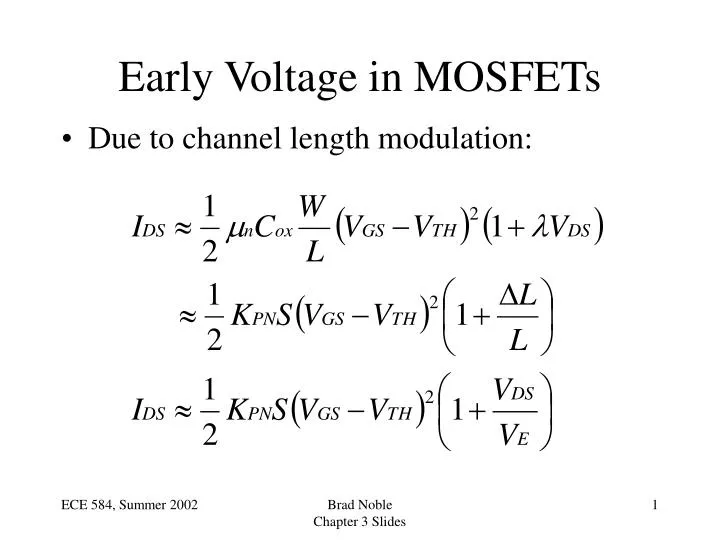s1a3
Newbie

I need to find early voltage for this circuit (PSpice 9.2 schematics) .

I already have IDS, VGS, VDS for the formula given below (in a picture). I wish to find lamda for finding early voltage (= 1/lamda).
I think W, L, VTH (= VTO) are in the data below. I am not sure where Un, Cox are.

I already have IDS, VGS, VDS for the formula given below (in a picture). I wish to find lamda for finding early voltage (= 1/lamda).
I think W, L, VTH (= VTO) are in the data below. I am not sure where Un, Cox are.
- Is Kp down there the same KPN of the formula?
- Are all the units if the model data in SI unit?
- Is there a better way to find early voltage for the above circuit?
*BeginSpec
*XC:
*TC:
*RR: Id=-0 Rdson=0 Vgs=-10
*ZL: Idss=-0 Vds=-0
*TO: Qgd=0 Qgs=0 Vds=-50 Id=-50
*OC:
*ST: tf=0 Id=-0 Vdd=-20 Zo=5
*RD:
*EndSpec
*BeginTrace
*XC: 0,0,-0,-50,1,3,0,0,-1 (27)
*TC: 0,0,-5,10,1,3,0,0,-1 (27)
*RR: 0,0,-0,-50,1,3,0,0,-1 (27)
*ZL: 0,0,-0,-50,1,3,0,0,-1 (27)
*TO: 0,0,0,100.00E-9,1,3,0,0,-1 (27)
*OC: 0,0,-0,-50,1,3,0,0,-1 (27)
*ST: 0,0,-0,-50,1,3,0,0,-1 (27)
*RD: 1,0,-.8,-4,1,3,0,0,-1 (27)
*EndTrace
*BeginParam
*LEVEL=3 (1,4,1)
*L=2.0000E-6 (1.0000E-18,1.0000E30,0)
*W=1.9000 (1.0000E-18,1.0000E30,0)
*KP=10.150E-6 (1.0000E-18,1.0000E30,0)
*RS=70.600E-3 (1.0000E-18,1.0000E30,0)
*RD=60.660E-3 (1.0000E-18,1.0000E30,0)
*VTO=-3.6700 (-1.0000E30,1.0000E30,0)
*RDS=444.40E3 (1.0000E-9,1.0000E30,0)
*TOX=100.00E-9 (1.0000E-18,1.0000E30,0)
*CGSO=877.20E-12 (1.0000E-18,1,0)
*CGDO=369.30E-12 (1.0000E-18,1,0)
*CBD=2.1410E-9 (1.0000E-18,1,0)
*MJ=.5 (.1,1.5000,0)
*PB=.8 (.3905,3,0)
*FC=.5 (.1,5,0)
*RG=.811 (10.000E-3,1.0000E30,0)
*IS=52.230E-18 (1.0000E-18,.1,0)
*N=2 (.1,5,0)
*RB=1.0000E-3 (1.0000E-9,100,0)
*PHI=.6 (1.0000E-3,1.0000E30,1)
*GAMMA=0 (0,1.0000E30,1)
*DELTA=0 (0,1.0000E30,1)
*ETA=0 (0,1.0000E30,1)
*THETA=0 (0,1.0000E30,1)
*KAPPA=.2 (0,1.0000E30,1)
*VMAX=0 (0,1.0000E30,1)
*XJ=0 (0,1.0000E30,1)
*UO=300 (100.00E-18,1.0000E30,1)
*EndParam
*DEVICE=IRF9140-X,PMOS
* IRF9140-X PMOS model
* created using Model Editor release 9.2 on 02/15/22 at 18:49
* The Model Editor is a PSpice product.
.MODEL IRF9140-X PMOS
LEVEL=3
L=2.0000E-6
W=1.9000
KP=10.150E-6
RS=70.600E-3
RD=60.660E-3
VTO=-3.6700
RDS=444.40E3
TOX=100.00E-9
CGSO=877.20E-12
CGDO=369.30E-12
CBD=2.1410E-9
RG=.811
IS=52.230E-18
N=2
TT=140N)
RB=1.0000E-3
GAMMA=0
UO=300
*$


